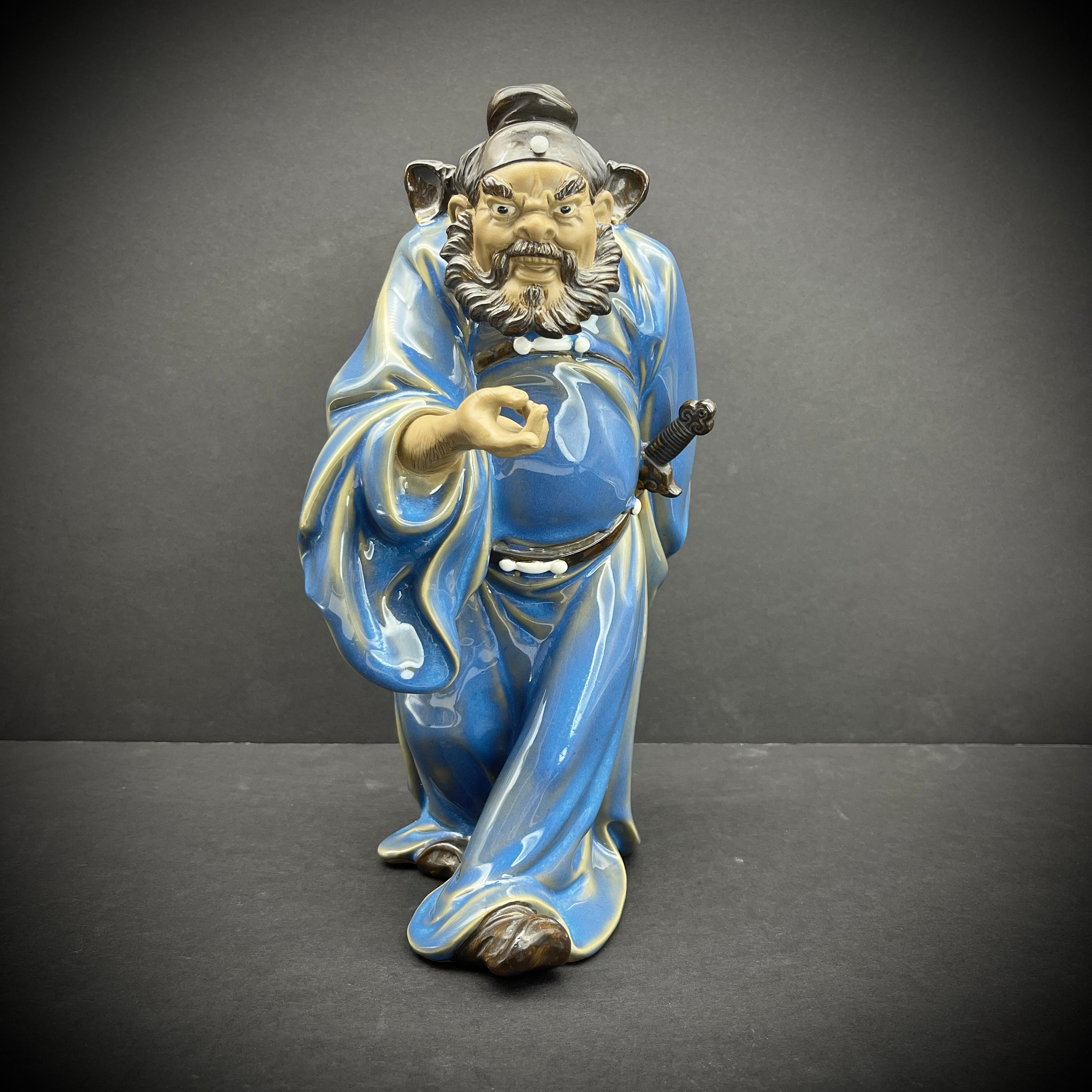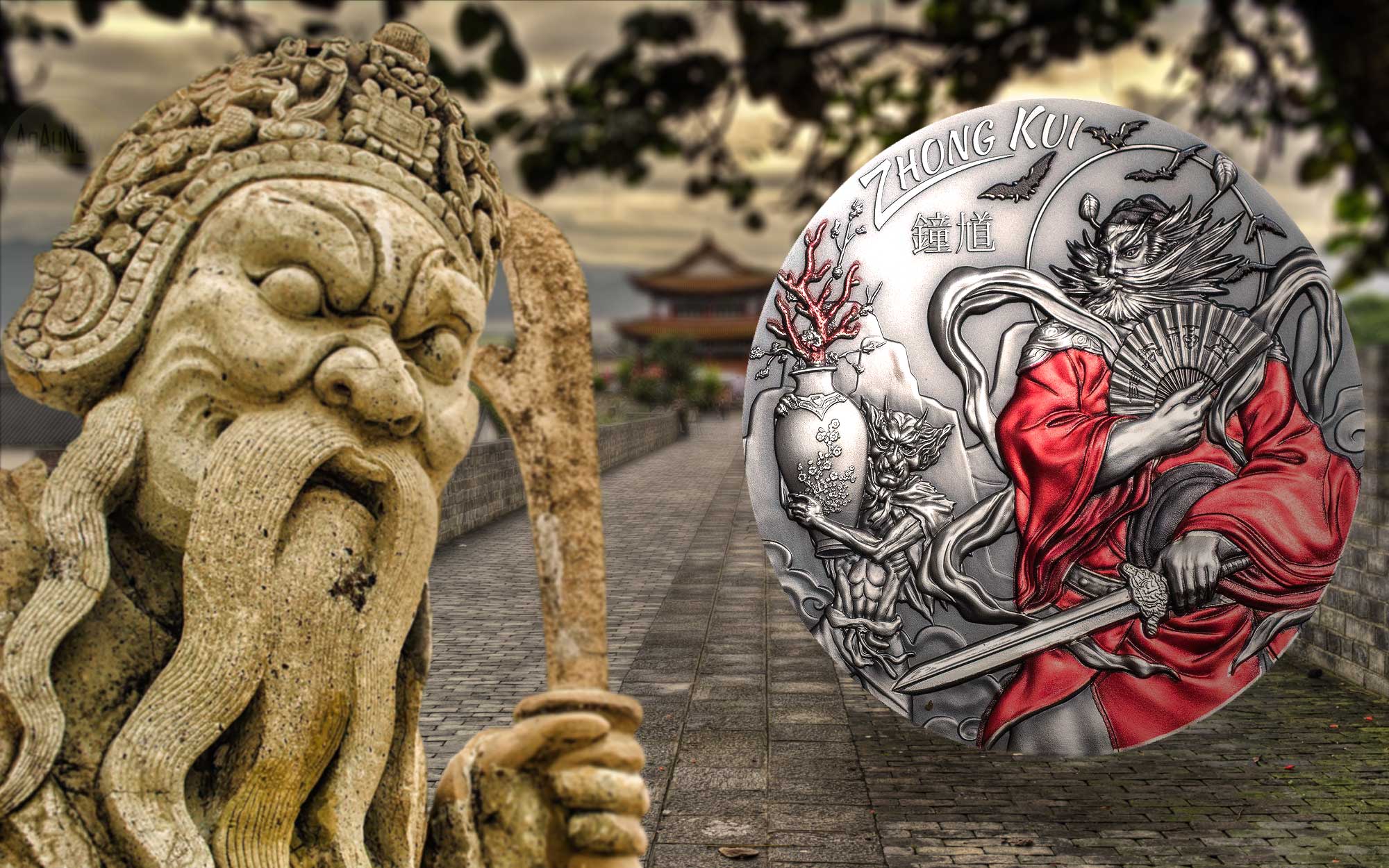
Zhong Kui from Smite by BrandonIsNear on Newgrounds
Zhong Kui god is a powerful deity in Chinese Taoist mythology. Also known as the Hunter of Demons and the King of Ghosts, Zhong Kui possesses the ability to control over 80,000 demons. With his distinctive appearance of a large man with a black beard, bulging eyes, and an angry expression, he is often depicted in Chinese art and folklore.

Chinese GodZhongkui on Behance
Known as the Demon Hunter and King of Ghosts, Zhong Kui (鍾馗) is a Chinese folk hero who fights ghosts and hunts demons. Legend has it Zhong Kui commands more than 80,000 ghosts and demons himself. His name is comprised of the surname zhōng (鍾) and kuí (馗), a word which means "crossroads." Mythology Zhong Kui's legend was a tragic one.

Finely Carved Vintage Shoki Demon Hunter Zhong Kui Chinese Boxwood
Zhong Kui ( Chinese: 鍾馗; pinyin: Zhōng Kuí; Korean: 종규, romanized : Jonggyu; Japanese: 鍾馗, romanized : Shōki; Vietnamese: Chung Quỳ) is a Taoist deity in Chinese mythology, traditionally regarded as a vanquisher of ghosts and evil beings. He is depicted as a large man with a big black beard, bulging eyes, and a wrathful expression.

Zhong Kui Official SMITE Wiki
The origins of the engrossing legends of Zhong Kui cannot be firmly established. In the best-known account, by Shen Gua (1031-1095), he was an unrecognized talent in the martial arts who appeared in a dream of the Tang emperor Xuanzong (r. 712-56) to kill a harassing demon.

Zhong Kui Chinese Shiwan Statue Porcelain Figurine Blue Demon Etsy
Zhong Kui is a character in many Chinese operas, TV shows, movies, and video games. In Japanese culture, Zhong Kui is known as Shōki. The oldest known image of Shōki dates back to the reign of the Japanese Emperor Goshirakawa (1127-1192). In Kyoto city, some people still hang Zhong Kui's image on the eaves and rooftops of their homes.

Zhong Kui Official SMITE Wiki
Vanquisher of demons, Zhong Kui plays an important role as a mythological guardian figure, popular in Chinese art from as early as the Tang dynasty. According to legend, he is himself a ghost who died by suicide after he was unjustly dishonoured by the emperor.

Zhong Kui Official SMITE Wiki
Zhong Kui is a legendary figure in East Asian countries. In China, it is customary that by the end of the year in preparation for the New Year, people hang his portrait on their doors as he is the auspicious spirit that protects people from demons and cures incurable diseases.

Zhong Kui, vanquisher of evil, is the subject of the first Asian
The Demon Queller Zhong Kui Giving His Sister Away in Marriage Yan Geng Chinese Yuan dynasty (1271-1368) Not on view Here, the legendary "demon queller" Zhong Kui leads his sister to her new home accompanied by an escort of demons performing feats of martial prowess.

Collection Seiko brass Zhong Kui the exorcism statue
February 12, 2021 Zhong Kui and the Lunar New Year (Fig. 1) Shoki (Zhong Kui) Vanquishing a Demon, Katsukawa Shunsho (1726-1792), Japan, Edo period, early 1770s, woodblock print, ink and color on paper, The Anne van Biema Collection, Arthur M. Sackler Gallery, S2004.3.323. Zhong Kui is a legendary figure in East Asian countries.

11" Chinese FengShui Myth Tianshic Zhong Kui ZhongKui Book Shou Statue
Zhong Kui, A Chinese Ghostbuster By Awen Aug 1, 2019 August 1 is the first day of lunar July in 2019 and lunar July is viewed as the ghost month in Chinese tradition since it is the time when the border security between the yin-yang worlds is a bit slack so the shadowy beings could easily sneak into the human domain to wreak havoc.

Zhong Kui Empires
Zhong Kui is commonly depicted with a sword in hand, befitting his role as a demon exorcist. The 11th century polymath Shen Kuo tells the story in Mengxi bitan (Conversations with a Writing Brush) of the Emperor Xuanzong who fell gravely ill from a mysterious ailment. His condition continued to worsen for almost a month, and doctors were unable to cure him.

Pin on Mythology, Folklore and other epic stories
Zhong Kui's representation as a fierce warrior, armed with a sword and accompanied by his trusty demon-quelling brush, exudes an aura of power that instills both awe and reverence. His supernatural features, such as the his flowing beard, add to his mystique and make him an instantly recognizable figure in Chinese art.

Finely Carved Vintage Shoki Demon Hunter Zhong Kui Chinese Boxwood
Zhong Kui is a legendary figure in East Asian countries. In China, it is customary that by the end of the year, and in preparation for the new year, people hang Zhong Kui's portrait on their doors, as he is the auspicious spirit who protects people from demons and cures incurable diseases.

ZHONG KUI THE DEMON QUELLER Daoism, Chinese Brush, Korean Art, China
Zhong Kui 鍾馗, seldomly written 鍾葵, is a person figuring in Chinese tales and stories as a fighter against demons and evil spirits. He is therefore usually called "the demon queller". In his book Bu mengqi bitan 補夢溪筆談 the Song period 宋 (960-1279) scholar Shen Kuo (1031-1095) writes that the Tang period 唐 (618-907) court painter Wu Daozi 吳道子 once created a painting of.

10'' China Mythology The Exorcist Zhong Kui Slaughter Devil Bronze
profession was Zhong Kui's aspiration. His position as the patron deity of the scholar was well established by Ming;9 but, even by Southern Song Zhong Kui was known and linked, as we have seen, to the exorcism of demons and evil spirits at the year-end ceremonies and festivals at the Southern Song capital, Hangzhou.

Zhong Kui Official SMITE Wiki
Zhong Kui is one of the most well-loved folk heroes of Chinese mythology. Read on to find out how a disgraced scholar won an army of demons! Mike Greenberg, PhD In Imperial China, a man's fortunes could be made or lost based on the result of one test.